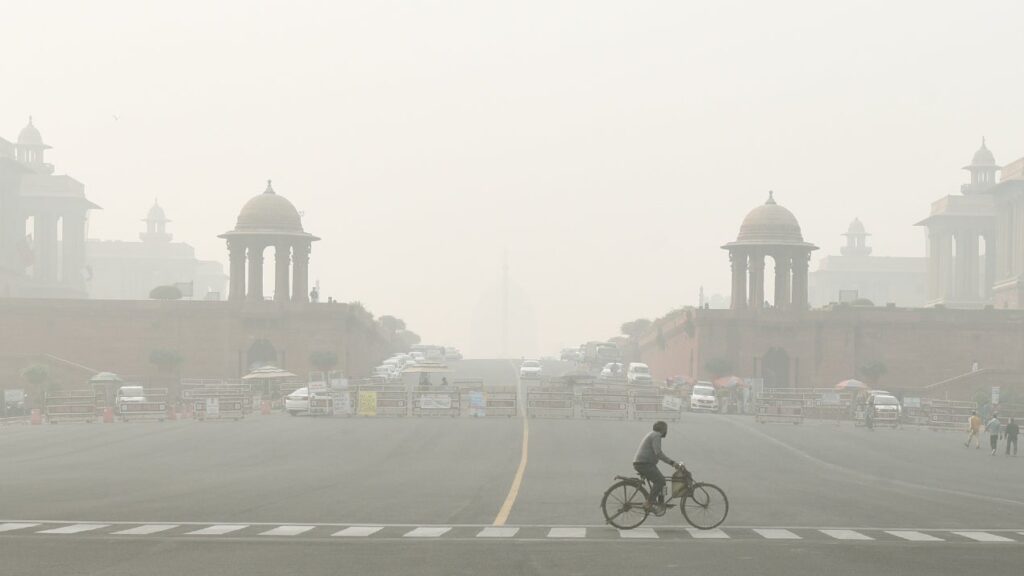Delhi Air Pollution Crisis: Supreme Court Questions Delay in Anti-Pollution Measures
For the first time this season, Delhi’s air quality has dipped to the ‘severe plus’ category. The Supreme Court on Monday criticized the Delhi government’s delay in implementing appropriate anti-pollution measures. During arguments over a contempt plea, the court expressed concern about waiting for the Air Quality Index (AQI) to breach 300 before initiating action.
The issue surfaced during the hearing of a petition seeking strict enforcement of anti-pollution measures. Petitioners argued that the situation has worsened due to the authorities’ lack of timely intervention. The apex court emphasized the need for immediate steps to curb air pollution and directed the Delhi government not to relax any restrictions under the Graded Response Action Plan (GRAP) without its approval.
AQI Reaches Critical Levels
On Monday morning, data from the System of Air Quality and Weather Forecasting and Research (SAFAR) displayed an AQI of 481 in Delhi—a frightening number. Many monitoring stations reported AQI levels nearing the maximum measurable limit of 500. Dwarka and Najafgarh recorded the worst levels, translating to extreme air pollution that poses significant health risks to residents.
GRAP Stage IV Activated
In response to the crisis, the Commission for Air Quality Management (CAQM) has activated Stage IV of GRAP with the following measures:
- Ban on Diesel Vehicles: A ban has been imposed on Delhi-registered BS-IV or older diesel medium and heavy goods vehicles. Trucks and light commercial vehicles from outside Delhi are barred from entering, except those carrying essential goods.
- Work-from-Home Policies: Public and private offices are required to operate at 50% capacity, with the remaining workforce encouraged to work from home.
- Shift to Online Schooling: All schools, except for Classes 10 and 12, have moved to online mode.
- Additional Emergency Measures: Authorities may consider more stringent restrictions, including closing non-essential commercial activities and implementing an odd-even vehicle scheme.
Health Risks and PM2.5 Levels
The toxic smog blanketing Delhi has pushed PM2.5 levels to over 60 times the World Health Organization’s (WHO) recommended daily limit. Fine particulate matter like PM2.5 is particularly dangerous because it can penetrate deep into the lungs and bloodstream, causing severe health issues.
Politics of Blame
The air pollution crisis has also fueled political tensions. Delhi Chief Minister Atishi accused the central government of inaction and politicizing the issue of stubble burning, a significant contributor to winter pollution. She alleged that incidents of stubble burning in neighboring states like Madhya Pradesh have increased yearly without adequate intervention from the central authorities.
Court’s Observations and Public Safety Concerns
The Supreme Court expressed dissatisfaction with the Delhi government’s handling of the crisis, questioning the delay in implementing preventive measures.
“Why did we wait for the AQI to cross 300? How could the government take such a risk?” the bench remarked. The court also warned against relaxing GRAP-4 measures without prior approval.
Public and Environmental Response
The choking smog has alarmed health experts and environmentalists, who are urging immediate action to safeguard public health. Residents have been advised to:
- Stay indoors.
- Use air purifiers.
- Wear masks when venturing outside.
Way Forward
While emergency measures have been initiated, long-term solutions are necessary to tackle the root causes of Delhi’s air pollution. Some suggested steps include:
- Strengthening Agricultural Policies: Providing incentives to farmers for adopting eco-friendly alternatives to stubble burning.
- Promoting Public Transport: Expanding metro services and encouraging the use of electric vehicles to reduce vehicular emissions.
- Curbing Industrial Emissions: Strictly enforcing emission standards for factories and construction sites.
This crisis is a wake-up call for collective action to combat air pollution. As the situation unfolds, it remains to be seen whether sustainable solutions will be implemented to ensure cleaner air for Delhi’s residents.

